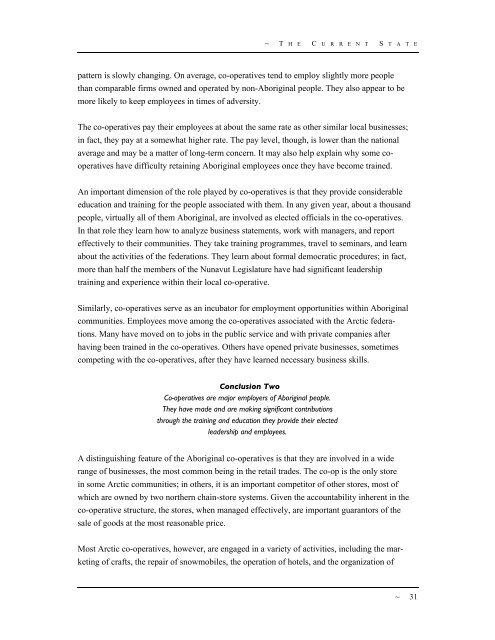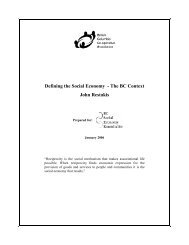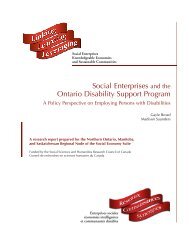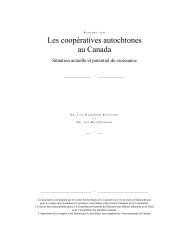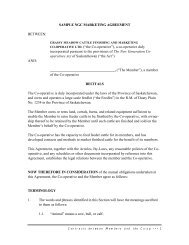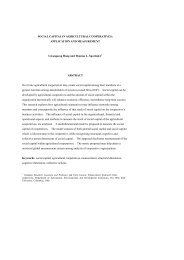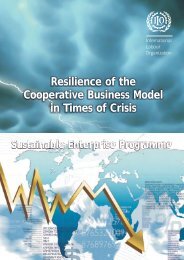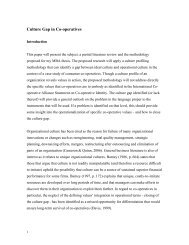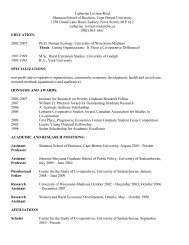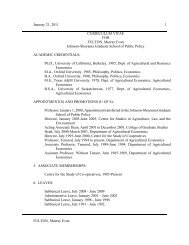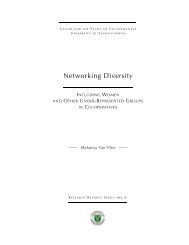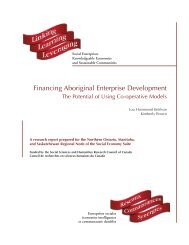Aboriginal Co-operatives in Canada - Centre for the Study of Co ...
Aboriginal Co-operatives in Canada - Centre for the Study of Co ...
Aboriginal Co-operatives in Canada - Centre for the Study of Co ...
Create successful ePaper yourself
Turn your PDF publications into a flip-book with our unique Google optimized e-Paper software.
~ T H E C U R R E N T S T A T Epattern is slowly chang<strong>in</strong>g. On average, co-<strong>operatives</strong> tend to employ slightly more peoplethan comparable firms owned and operated by non-<strong>Aborig<strong>in</strong>al</strong> people. They also appear to bemore likely to keep employees <strong>in</strong> times <strong>of</strong> adversity.The co-<strong>operatives</strong> pay <strong>the</strong>ir employees at about <strong>the</strong> same rate as o<strong>the</strong>r similar local bus<strong>in</strong>esses;<strong>in</strong> fact, <strong>the</strong>y pay at a somewhat higher rate. The pay level, though, is lower than <strong>the</strong> nationalaverage and may be a matter <strong>of</strong> long-term concern. It may also help expla<strong>in</strong> why some co<strong>operatives</strong>have difficulty reta<strong>in</strong><strong>in</strong>g <strong>Aborig<strong>in</strong>al</strong> employees once <strong>the</strong>y have become tra<strong>in</strong>ed.An important dimension <strong>of</strong> <strong>the</strong> role played by co-<strong>operatives</strong> is that <strong>the</strong>y provide considerableeducation and tra<strong>in</strong><strong>in</strong>g <strong>for</strong> <strong>the</strong> people associated with <strong>the</strong>m. In any given year, about a thousandpeople, virtually all <strong>of</strong> <strong>the</strong>m <strong>Aborig<strong>in</strong>al</strong>, are <strong>in</strong>volved as elected <strong>of</strong>ficials <strong>in</strong> <strong>the</strong> co-<strong>operatives</strong>.In that role <strong>the</strong>y learn how to analyze bus<strong>in</strong>ess statements, work with managers, and reporteffectively to <strong>the</strong>ir communities. They take tra<strong>in</strong><strong>in</strong>g programmes, travel to sem<strong>in</strong>ars, and learnabout <strong>the</strong> activities <strong>of</strong> <strong>the</strong> federations. They learn about <strong>for</strong>mal democratic procedures; <strong>in</strong> fact,more than half <strong>the</strong> members <strong>of</strong> <strong>the</strong> Nunavut Legislature have had significant leadershiptra<strong>in</strong><strong>in</strong>g and experience with<strong>in</strong> <strong>the</strong>ir local co-operative.Similarly, co-<strong>operatives</strong> serve as an <strong>in</strong>cubator <strong>for</strong> employment opportunities with<strong>in</strong> <strong>Aborig<strong>in</strong>al</strong>communities. Employees move among <strong>the</strong> co-<strong>operatives</strong> associated with <strong>the</strong> Arctic federations.Many have moved on to jobs <strong>in</strong> <strong>the</strong> public service and with private companies afterhav<strong>in</strong>g been tra<strong>in</strong>ed <strong>in</strong> <strong>the</strong> co-<strong>operatives</strong>. O<strong>the</strong>rs have opened private bus<strong>in</strong>esses, sometimescompet<strong>in</strong>g with <strong>the</strong> co-<strong>operatives</strong>, after <strong>the</strong>y have learned necessary bus<strong>in</strong>ess skills.<strong>Co</strong>nclusion Two<strong>Co</strong>-<strong>operatives</strong> are major employers <strong>of</strong> <strong>Aborig<strong>in</strong>al</strong> people.They have made and are mak<strong>in</strong>g significant contributionsthrough <strong>the</strong> tra<strong>in</strong><strong>in</strong>g and education <strong>the</strong>y provide <strong>the</strong>ir electedleadership and employees.A dist<strong>in</strong>guish<strong>in</strong>g feature <strong>of</strong> <strong>the</strong> <strong>Aborig<strong>in</strong>al</strong> co-<strong>operatives</strong> is that <strong>the</strong>y are <strong>in</strong>volved <strong>in</strong> a widerange <strong>of</strong> bus<strong>in</strong>esses, <strong>the</strong> most common be<strong>in</strong>g <strong>in</strong> <strong>the</strong> retail trades. The co-op is <strong>the</strong> only store<strong>in</strong> some Arctic communities; <strong>in</strong> o<strong>the</strong>rs, it is an important competitor <strong>of</strong> o<strong>the</strong>r stores, most <strong>of</strong>which are owned by two nor<strong>the</strong>rn cha<strong>in</strong>-store systems. Given <strong>the</strong> accountability <strong>in</strong>herent <strong>in</strong> <strong>the</strong>co-operative structure, <strong>the</strong> stores, when managed effectively, are important guarantors <strong>of</strong> <strong>the</strong>sale <strong>of</strong> goods at <strong>the</strong> most reasonable price.Most Arctic co-<strong>operatives</strong>, however, are engaged <strong>in</strong> a variety <strong>of</strong> activities, <strong>in</strong>clud<strong>in</strong>g <strong>the</strong> market<strong>in</strong>g<strong>of</strong> crafts, <strong>the</strong> repair <strong>of</strong> snowmobiles, <strong>the</strong> operation <strong>of</strong> hotels, and <strong>the</strong> organization <strong>of</strong>~ 31


